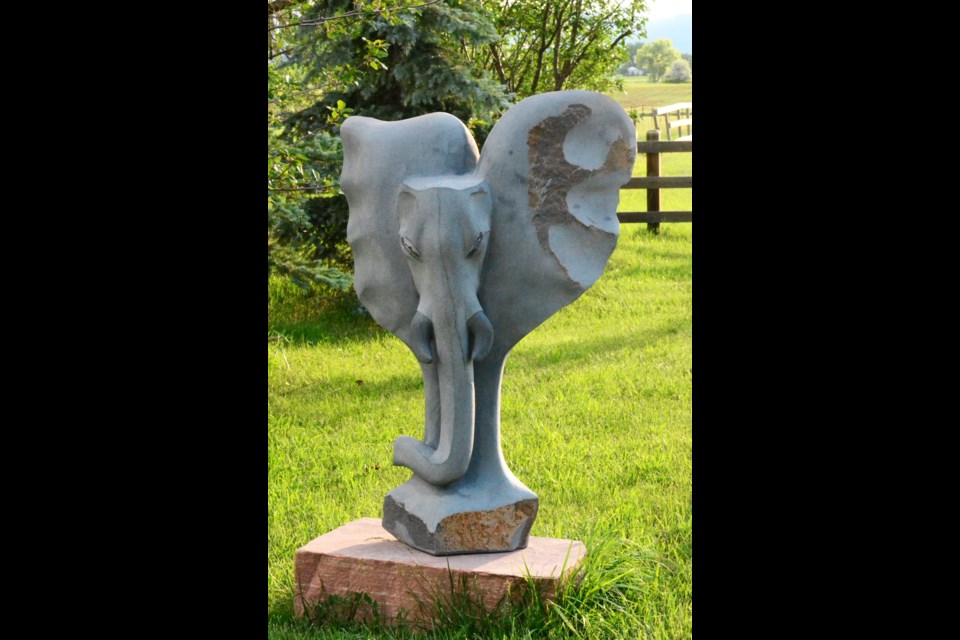SaToro Tafura, a sculptor whose primary medium is stone, grew up in Zimbabwe in the Eastern Highlands near the border with Mozambique, in a family of artists. His mother, several of his mother's siblings and his grandfather are all artists. He came to the U.S. in 2004 and lived in California in the Bay Area for four years. In 2008, he arrived in Colorado because he was commissioned to bring a piece to a sculpture park in Loveland. He now resides in Longmont with his wife, Marissa, his son, Kwayedza, and his daughter, Waniso.
While there is a family legacy in the field, Tafura's love for the art form is his own. It stems from the chance to explore his identity and heritage as well as the way it speaks across cultures. Tafura also loves the freedom of expression and therapeutic value that creating art offers. He especially enjoys the surprises.
"I'm not imitating something that's already been done, so I'm always amazed by what comes up in the art piece. I'm in awe of the unexpected that I come across during my practice. Sometimes you can't tell what's coming tomorrow," Tafura shared.
Tafura recently exhibited at the 12-Feet Apart Art Exhibition on June 5 in Lafayette. The organizer has hosted shows for the last few years, but this one was a bit different.
Of course, the name was inspired by the six feet of social distancing rule, but Tafura explained that it wasn't the people that were separated by 12 feet; it was the artwork. There was no specific booth setup. The art was staggered throughout a garden. He said he'd never exhibited in a show quite like it.
For Tafura, part of exploring the way a piece speaks to him and helping it to communicate to others is in investigating his own history, culture and identity. As an artist, he has reclaimed his original name. While it only became his name legally at the end of last year, he has used his current name for the last five years.
"When the Europeans came to Africa or other places, one thing they did for their colonial project to be successful was to take away your identity. One of the ways they did that was to give you a name, to name you after them and to try and get you to imitate their culture. They took you out of your village and put you in boarding schools," Tafura said. "So, now, one of the things I needed to do was to remove some of what the Empire imposed on us. One of the things I have changed as an artist is my artist name."
His identity as an artist formed early on in his childhood. He grew up in and around his family's studios.
"As they say, sometimes, your calling finds you. I think that just growing up in it and being something that I saw every day and seeing it, growing comfortable with it, made me decide that's what I wanted to do," Tafura said.
His mom made him go to college first, where he studied International Tourism, a program that would only take two years. The whole time, he'd travel back on weekends and holidays and work in his mom's studio. As soon as he completed the program, he went right back to his art.
Tafura's stone sculptures always use stone from Zimbabwe which can be especially challenging to procure.
"When I have a piece that I need to do, which is in my head, and I don't have the material, and I know the material isn't on its way, and I cannot get it right now, it's challenging. You might end up working on a piece for five years instead of three because you haven't been able to access the other material that is on the other side to finish this piece. For some pieces, you need a whole lot of stone,” Tafura said.
One piece he was commissioned to do weighed 11 tons at completion.
Tafura finds his art to be therapeutic. That therapeutic peace and the balance he finds in sculpting were especially beneficial during the COVID-19 shutdowns. He had a place to go where he could isolate himself while working with the stone.
"Working on it during COVID was pretty good because it was just driving from home straight to the sculpture where there's nobody there and doing my work then driving home."
To see more of his work, people can make an appointment to go to the studio/outdoor gallery by emailing [email protected].


